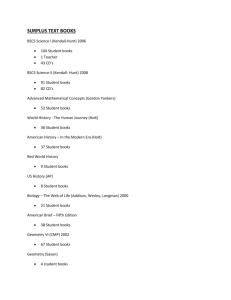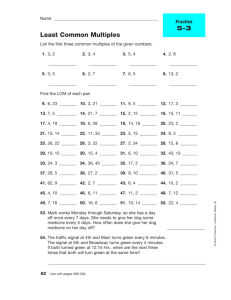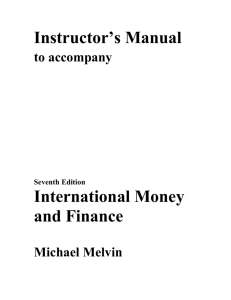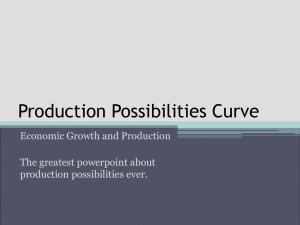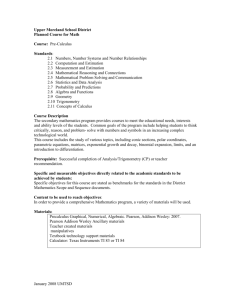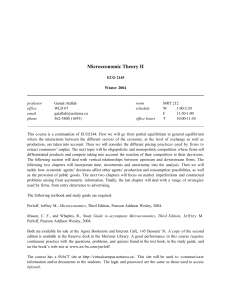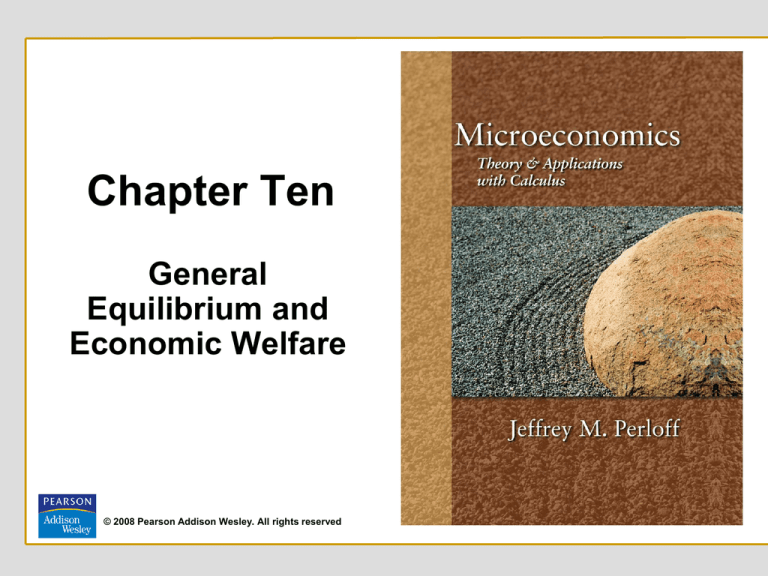
Chapter Ten
General
Equilibrium and
Economic Welfare
© 2008 Pearson Addison Wesley. All rights reserved
General Equilibrium
and Economic Welfare
• In this chapter, we examine five main
topics
– General Equilibrium
– General-Equilibrium: Trading
Between Two People
– Competitive Exchange
– Production and Trading
– Efficiency and Equity
© 2008 Pearson Addison Wesley. All rights reserved.
10-2
General Equilibrium
• partial-equilibrium analysis
– an examination of equilibrium and
changes in equilibrium in one market
in isolation
• general-equilibrium analysis
– the study of how equilibrium is
determined in all markets
simultaneously
© 2008 Pearson Addison Wesley. All rights reserved.
10-3
Competitive Equilibrium in
Two Interrelated Markets
• Sequence of Events
– We can demonstrate the effect of a
shock in one market on both markets
by tracing the sequence of events in
the two markets.
– Whether these steps occur nearly
instantaneously or take some times
depends on how quickly consumers
and producers react.
© 2008 Pearson Addison Wesley. All rights reserved.
10-4
Figure 10.1 Relationship Between
the Corn and Soybean Markets
© 2008 Pearson Addison Wesley. All rights reserved.
10-5
Equation 10.1
© 2008 Pearson Addison Wesley. All rights reserved.
10-6
Equation 10.2
© 2008 Pearson Addison Wesley. All rights reserved.
10-7
Equation 10.3
© 2008 Pearson Addison Wesley. All rights reserved.
10-8
Equation 10.4
© 2008 Pearson Addison Wesley. All rights reserved.
10-9
Competitive Equilibrium in
Two Interrelated Markets
• To solve for the equilibrium p1, p2, Q1,
and Q2, we need to solve these four
unknowns simultaneously.
© 2008 Pearson Addison Wesley. All rights reserved.
10-10
Equation 10.5
© 2008 Pearson Addison Wesley. All rights reserved.
10-11
Equation 10.6
© 2008 Pearson Addison Wesley. All rights reserved.
10-12
Equation 10.7
© 2008 Pearson Addison Wesley. All rights reserved.
10-13
Equation 10.8
© 2008 Pearson Addison Wesley. All rights reserved.
10-14
Minimum Wages With
Incomplete Coverage
• Minimum Wages With Incomplete Coverage
– In the absence of a minimum wage, the
equilibrium wage is w1 .
– Applying a minimum wage, w , to only one
sector causes the quantity of labor
services demanded in the covered sector
to fall.
– The extra labor moves to the uncovered
sector, driving the wage there down to w2 .
© 2008 Pearson Addison Wesley. All rights reserved.
10-15
Figure 10.1
Minimum Wage with Incomplete Coverage
© 2008 Pearson Addison Wesley. All rights reserved.
10-16
General-Equilibrium Exchange
Economy: Trading Between Two
People
• Endowments
– an initial allocation of goods
• Pareto efficient
– describing an allocation of goods or
services such that any reallocation
harms at least one person
© 2008 Pearson Addison Wesley. All rights reserved.
10-17
Figure 10.2(a) and (b)
Endowments in an Edgeworth Box
© 2008 Pearson Addison Wesley. All rights reserved.
10-18
Figure 10.2(c)
Endowments in an Edgeworth Box
© 2008 Pearson Addison Wesley. All rights reserved.
10-19
Mutually Beneficial Trades
• We make four assumptions about their
tastes and behavior:
– Utility maximization
– Usual-shaped indifference curves
– Nonsatiation
– No interdependence
© 2008 Pearson Addison Wesley. All rights reserved.
10-20
Figure 10.3
Contract Curve
© 2008 Pearson Addison Wesley. All rights reserved.
10-21
Mutually Beneficial Trades
Trades are possible where
indifference curves intersect because
marginal rates of substitution are
unequal.
© 2008 Pearson Addison Wesley. All rights reserved.
10-22
Mutually Beneficial Trades
• To summarize, we can make four
equivalent statements about allocation f :
1.The indifference curves of the two
parties are tangent at f .
2.The parties’ marginal rates of
substitution are equal at f .
3.No further mutually beneficial trades are
possible at f .
4.The allocation at f is Pareto efficient:
One party cannot be made better off
without harming the other.
© 2008 Pearson Addison Wesley. All rights reserved.
10-23
Mutually Beneficial Trades
• Indifference curves are also tangent at
Bundles b , c , and d , so these
allocations, like f , are Pareto efficient.
• By connecting all such bundles, we
draw the contract curve: the set of all
Pareto-efficient bundles.
© 2008 Pearson Addison Wesley. All rights reserved.
10-24
Deriving the Contract
Curve
• We can use calculus to derive the
contract curve.
• Using a Lagrangian multiplier approach,
we can pose the problem as shown in
equation (10.9).
© 2008 Pearson Addison Wesley. All rights reserved.
10-25
Equation 10.9
© 2008 Pearson Addison Wesley. All rights reserved.
10-26
Equation 10.10
© 2008 Pearson Addison Wesley. All rights reserved.
10-27
Equation 10.11
© 2008 Pearson Addison Wesley. All rights reserved.
10-28
Equation 10.12
© 2008 Pearson Addison Wesley. All rights reserved.
10-29
Equation 10.13
© 2008 Pearson Addison Wesley. All rights reserved.
10-30
Bargaining Ability
• All the allocations in area B are
beneficial.
• Where will they end up on the contract
curve between b and c ?
• That depends on who is better at
bargaining.
© 2008 Pearson Addison Wesley. All rights reserved.
10-31
Competitive Exchange
• The First Theorem of Welfare
Economics
– The competitive equilibrium is efficient:
Competition results in a Paretoefficient allocation—no one can be
made better off without making
someone worse off—in all markets.
© 2008 Pearson Addison Wesley. All rights reserved.
10-32
Competitive Exchange
• The Second Theorem of Welfare
Economics
– Any efficient allocations can be
achieved by competition: All possible
efficient allocations can be obtained
by competitive exchange, given an
appropriate initial allocation of goods.
© 2008 Pearson Addison Wesley. All rights reserved.
10-33
Competitive Equilibrium
•
The initial endowment is e .
a) If, along the price line facing Jane
and Denise, pw $2 and pc $1 ,
they trade to point f , where Jane’s
2
indifference curve, I j , is tangent to
the price line and to Denise’s
indifference curve, I d2 .
© 2008 Pearson Addison Wesley. All rights reserved.
10-34
Competitive Equilibrium
b) No other price line results in an
equilibrium, If pw $1.33 and pc $1 ,
Denise wants to buy 12 (=32-20)
cords of firewood at these prices,
but Jane wants to sell only 8 (=30-
22) cords. Similarly, Jane wants to
buy 10 (=30-20) candy bars, but
Denise wants to sell 17 (=60-43).
Thus these prices are not consistent
with a competitive equilibrium.
© 2008 Pearson Addison Wesley. All rights reserved.
10-35
Figure 10.4(a)
Competitive Equilibrium
© 2008 Pearson Addison Wesley. All rights reserved.
10-36
Figure 10.4(b)
Competitive Equilibrium
© 2008 Pearson Addison Wesley. All rights reserved.
10-37
The Efficiency of
Competition
• In a competitive equilibrium, the slope
(MRS) of each person’s indifference curve
equals the slope of the price line, so the
slopes of the indifference curves are equal:
pc
MRS j
MRSd
pw
• We have demonstrated the First Theorem of
Welfare Economics:
Any competitive equilibrium is Pareto
efficient.
© 2008 Pearson Addison Wesley. All rights reserved.
10-38
The Efficiency of
Competition
• The first welfare theorem tells us that
society can achieve efficiency by
allowing competition.
• The second welfare theorem adds that
society can obtain the particular
efficient allocation it prefers based on
its value judgments about equity by
appropriately redistributing
endowments (income).
© 2008 Pearson Addison Wesley. All rights reserved.
10-39
Obtaining Any Efficient
Allocation Using Competition
• Any Pareto-efficient bundle x can be
obtained as a competitive equilibrium if
the initial endowment is x.
• That allocation can also be obtained as
a competitive equilibrium if the
endowment lies on a price line through
x, where the slope of the price line
equals the marginal rate of substitution
of the indifference curve that are
tangent at x.
© 2008 Pearson Addison Wesley. All rights reserved.
10-40
Production and Trading
Comparative Advantage
• comparative advantage
– the ability to produce a good at a
lower opportunity cost than someone
else
© 2008 Pearson Addison Wesley. All rights reserved.
10-41
Comparative Advantage
• Production Possibility Frontier
– Jane’s production possibility frontier
( PPF j ), which shows the maximum
combinations of wood and candy that
she can produce from a given
amount of input.
© 2008 Pearson Addison Wesley. All rights reserved.
10-42
Comparative Advantage
• Marginal Rate of Transformation
– The slope of the production
possibility frontier is the marginal
rate of transformation (MRT).
© 2008 Pearson Addison Wesley. All rights reserved.
10-43
Comparative Advantage
• Benefits of Trade
– Because of the difference in their
marginal rates of transformation,
Jane and Denise can benefit from a
trade.
© 2008 Pearson Addison Wesley. All rights reserved.
10-44
Production and Trading
•
Comparative Advantage and
Production Possibility Frontiers.
a) Jane’s production possibility
frontier, PPF j , shows that in a day,
she can produce 6 cords of
firewood or 3 candy bars or any
combination of the two. Her
marginal rate of transformation
(MRT) is -2.
© 2008 Pearson Addison Wesley. All rights reserved.
10-45
Production and Trading
b) Denise’s production possibility 1
frontier, PPF d , has an MRT of 2 .
c) Their joint production possibility
frontier, PPF, has a kink at 6 cords
of firewood (produced by Jane) and
6 candy bars (produced by Denise)
and is concave to the origin.
© 2008 Pearson Addison Wesley. All rights reserved.
10-46
Equation 10.14
© 2008 Pearson Addison Wesley. All rights reserved.
10-47
Figure 10.5
Comparative Advantage and Production
Possibility Frontiers
© 2008 Pearson Addison Wesley. All rights reserved.
10-48
Efficient Product Mix
• Optimal Product Mix.
– The optimal product mix, a , could be
determined by maximizing an individual’s
utility by picking the allocation for which
an indifference curve is tangent to the
production possibility frontier.
– It could also be determined by picking the
allocation where the relative competitive
price, pc / p f , equals the slope of the PPF.
© 2008 Pearson Addison Wesley. All rights reserved.
10-49
Figure 10.6
Optimal Product Mix
© 2008 Pearson Addison Wesley. All rights reserved.
10-50
Efficient Product Mix
• The marginal rate of transformation
along this smooth PPF tells us about
the marginal cost of producing one
good relative to the marginal cost of
producing the other good.
MCc
MRT
MCw
© 2008 Pearson Addison Wesley. All rights reserved.
10-51
Competition
• Each price-taking consumer picks a
bundle of goods so that the
consumer’s marginal rate of
substitution equals the slope of the
consumer’s price line (the negative of
the relative prices):
pc
MRS
pw
© 2008 Pearson Addison Wesley. All rights reserved.
10-52
Competition
• If candy and wood are sold by
competitive firms, pc MCc and pw MCw
in the competitive equilibrium, the MRS
equals the relative prices, which equals
the MRT:
pc
MRS
MRT
pw
© 2008 Pearson Addison Wesley. All rights reserved.
10-53
Competition
• Because competition ensures that the
MRS equals the MRT, a competitive
equilibrium achieves an efficient product
mix: The rate at which firms can transform
one good into another equals the rate at
which consumers are willing to substitute
between the goods, as reflected by their
willingness to pay for the two goods.
• In this competitive equilibrium, supply
equals demand in all markets.
• The consumers buy the mix of goods at f .
© 2008 Pearson Addison Wesley. All rights reserved.
10-54
Figure 10.7
Competitive Equilibrium
© 2008 Pearson Addison Wesley. All rights reserved.
10-55
Efficiency and Equity
• Role of the Government
– By altering the efficiency with which goods
are produced and distributed and the
endowment of resources, governments
help determine how much is produced and
how goods are allocated.
– By redistributing endowments or by
refusing to do so, governments, at least
implicitly, are making value judgments
about which members of society should
get relatively more of society’s goodies.
© 2008 Pearson Addison Wesley. All rights reserved.
10-56
Efficiency
• We can use the Pareto principle to rank
allocations or government policies that
alter allocations.
• The Pareto criterion ranks allocation x
over allocation y if some people are
better off at x and no one else is
harmed.
• If that condition is met, we say that x is
Pareto superior to y .
© 2008 Pearson Addison Wesley. All rights reserved.
10-57
Efficiency
• The Pareto principle cannot always be
used to compare allocations.
• Because there are many possible
Pareto-efficient allocations, however, a
value judgment based on interpersonal
comparisons must be made to choose
between them.
© 2008 Pearson Addison Wesley. All rights reserved.
10-58
Equity
• If we are unwilling to use the Pareto
principle or if that criterion does not
allow us to rank the relevant allocations,
we must make additional value
judgments to rank these allocations.
• A way to summarize these value
judgments is to use a social welfare
function that combines various
consumers’ utilities to provide a
collective ranking of allocations.
© 2008 Pearson Addison Wesley. All rights reserved.
10-59
Equity
• Who decides on the welfare function?
• In most countries, government leaders
make decisions about which
allocations are most desirable.
© 2008 Pearson Addison Wesley. All rights reserved.
10-60
Figure 10.8
Welfare Maximization
© 2008 Pearson Addison Wesley. All rights reserved.
10-61
Equity
• Voting
– In a democracy, important government
policies that determine the allocation of
goods are made by voting.
– Such democratic decision making is
often difficult because people
fundamentally disagree on how issues
should be resolved and which groups of
people should be favored.
© 2008 Pearson Addison Wesley. All rights reserved.
10-62
Equity
• Unfortunately, sometimes voting does
not work well, and the resulting social
ordering of allocations is not transitive.
© 2008 Pearson Addison Wesley. All rights reserved.
10-63
Table 10.1
Preferences over Allocations of Three People
© 2008 Pearson Addison Wesley. All rights reserved.
10-64
Equity
• Arrow’s Impossibility Theorem.
• Arrow suggested that a socially
desirable decision making system, or
social welfare function, should
satisfy the following criteria:
– Social preferences should be
complete and transitive, like
individual preferences.
© 2008 Pearson Addison Wesley. All rights reserved.
10-65
Equity
– If everyone prefers Allocation a to
Allocation b , a should be socially
preferred to b .
– Society’s ranking of a and b should
depend only on individual’s ordering
of these two allocations, not on how
they rank other alternatives.
– Dictatorship is not allowed; social
preferences must not reflect the
preferences of only a single person
© 2008 Pearson Addison Wesley. All rights reserved.
10-66
Equity
• Although each of these criteria seems
reasonable—indeed, innocuous—
Arrow proved that it is impossible to
find a social decision-making rule that
always satisfies all of these criteria.
© 2008 Pearson Addison Wesley. All rights reserved.
10-67
Equity
• Social Welfare Functions.
– How would you rank various
allocations if you were asked to vote?
• Jeremy Bentham (1748-1832) and his
followers (including John Stuart Mill),
the utilitarian philosophers, suggested
that society should maximize the sum
of the utilities of all members of society.
© 2008 Pearson Addison Wesley. All rights reserved.
10-68
Equity
• If U i is the utility of Individual i and there
are npeople, the utilitarian welfare
function is
W U1 U 2 U n .
• A generalization of the utilitarian approach
assigns different weights to various
individuals’ utilities.
• This generalized utilitarian welfare
function is
W 1U1 2U 2 nU n .
© 2008 Pearson Addison Wesley. All rights reserved.
10-69
Equity
• John Rawls (1971), a philosopher at
Harvard, believes that society should
maximize the well-being of the worst-off
member of society, who is the person with
the lowest level of utility.
• The Rawlsian welfare function is
W min U1 ,U 2 , ,U n .
Rawls’s rule leads to a relatively
egalitarian distribution of goods.
© 2008 Pearson Addison Wesley. All rights reserved.
10-70
Efficiency Versus Equity
• Given a particular social welfare
function, society might prefer an
inefficient allocation to an efficient
one.
© 2008 Pearson Addison Wesley. All rights reserved.
10-71
Efficiency Versus Equity
• Competitive equilibrium may not be
very equitable even though it is Pareto
efficient.
• Consequently, societies that believe in
equitable may tax the rich to give to the
poor.
• If the money taken from the rich is
given directly to the poor, society
moves from one Pareto-efficient
allocation to another.
© 2008 Pearson Addison Wesley. All rights reserved.
10-72
Efficiency Versus Equity
• Unfortunately, there is frequently a
conflict between a society’s goal of
efficiency and the goal of achieving an
equitable allocation.
• Even when the government
redistributes money from one group to
another, there are significant costs to
this redistribution.
© 2008 Pearson Addison Wesley. All rights reserved.
10-73
Theory of the Second Best
• It should be noticed that the argument
that competition maximizes efficiency
and our usual welfare measure holds if
we eliminate all distortions, but it does
not necessarily hold if we eliminate
only some of the distortions.
© 2008 Pearson Addison Wesley. All rights reserved.
10-74
Theory of the Second Best
• According to the Theory of the Second
Best (Lipsey and Lancaster, 1956), if an
economy has at least two market
distortions, correcting one of them may
either increase or decrease welfare.
• An example is shown in Figure 10.9 for
a country with a ban on free trade and a
subsidy on one good.
© 2008 Pearson Addison Wesley. All rights reserved.
10-75
Figure 10.9
Welfare Effect of Trade with and
Without a Subsidy
© 2008 Pearson Addison Wesley. All rights reserved.
10-76

